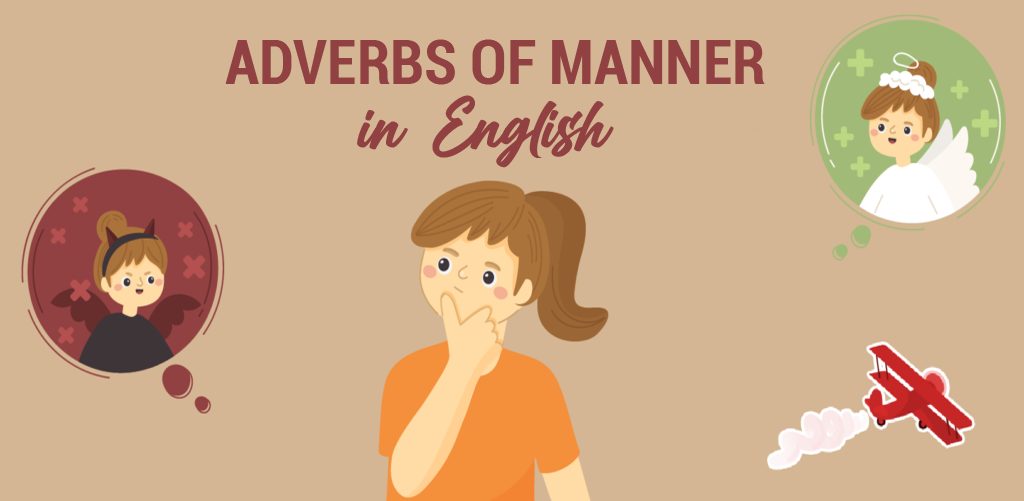Adverbs of manner in English

The adverbs of mode are used to indicate the way or how something is done. An adverb can be added to a verb to modify its meaning. “She plays piano.” (Ella toca el piano). You can add an adverb of mode to the verb (to play) to modify its meaning and give us more information about how you play the piano. She plays piano beautifully (Ella toca el piano maravillosamente).
ÍNDICE DE CONTENIDOS
Do not forget to certify your language level from the most advanced platform of the moment: Examenexam.
What is an adverb?
An adverb is a word that describes how, where, or how often we do an action (or “verb”) . For example:
- She works here (adverb of place).
Ella trabaja aquí (adverbio de lugar).
- She often translates emails for her colleagues (adverb of frequency).
A menudo traduce correos electrónicos para sus colegas (adverbio de frecuencia).
- She types very quickly (adverb of manner).
Ella escribe muy rápido (adverbio de modo).
Adverbs of manner
An adverb of a model describes how it performs an action. For example:
- She works very hard.
Ella trabaja muy duro.
- They dress elegantly.
Se visten elegantemente.
- Some elderly people drive slowly.
Algunas personas mayores conducen lentamente.
The mode adverbs are really useful because they allow us to add any additional details to the descriptions, to make what we say more interesting and dynamic for the listener or reader.
- She plays piano.
Ella toca el piano.
You can add an adverb of mode to the verb (play -tocar) to modify its meaning and give us more information about how you play the piano.
- She plays the piano beautifully.
Toca el piano maravillosamente.
- She plays piano softly.
Ella toca el piano suavemente.
Adverbs of manner are generally placed after the main verb or after the object. “He left the room quickly”. (Salió de la habitación rápidamente). Although it can also be used before the verb. He quickly left the room (salió rápidamente de la habitación).
Examples of adverbs of manner
- The rain fell heavily.
La lluvia cayó con fuerza.
- When my teacher speaks, we listen carefully.
Cuando mi maestro habla, escuchamos con atención
- Make sure you write neatly.
Asegúrate de escribir bien.
- She easily passed the test.
Ella pasó fácilmente la prueba.
How to create an adverb of mode?
To make adverbs of manner, we generally add -ly to the adjective. For example:
- Quick – quickly
Rápido-rápidamente
- Careful – carefully
Cuidado cuidadosamente
- Gentle – gently
Gentil – gentilmente
When an adjective ends in -y we change -y to -i and then we add -ly.
For example:
- Happy – happily
Feliz – felizmente
- Greedy – greedily
Codicioso – codiciosamente
- Easy – easily
Fácil-fácilmente
However, there are also some irregular adverbs:
- Good – well
bien
- Hard
duro
- Fast
rápido
- Late
tarde
- Straight
recto
- High
alta
Here are some examples:
- You speak English fluently.
Hablas inglés con fluidez.
- I slept badly last night.
Dormí mal anoche.
- The children did very well on the test.
A los niños les fue muy bien en la prueba.
- He worked hard and got a promotion.
Trabajó duro y consiguió un ascenso.
- The nurse picked up the baby gently.
La enfermera levantó al bebé con suavidad.
- Try to do it carefully so we don’t have to redo it.
Intente hacerlo con cuidado para que no tengamos que rehacerlo.
- A car suddenly came round the corner and nearly hit.
¡De repente, un coche dobló la esquina y casi choca!
What place does an adverb of mode occupy in a sentence?
In most cases, adverbs of manner come after a verb. For example,
- On Fridays, we dress casually.
Los viernes nos vestimos de manera informal.
- Athletes run very fast.
Los atletas corren muy rápido.
- Students listen carefully.
Los estudiantes escuchan atentamente.
Sometimes, however, the adverb is placed before the verb to add emphasis to the meaning. For example:
- He hastily opened the gift.
Abrió apresuradamente el regalo.
- Sadly they left before we arrived.
Tristemente se fueron antes de que llegáramos.
- I quickly ran to the stores.
Corrí rápidamente a las tiendas.
If there are two verbs in the sentence, the position of the adverb can change the meaning.
For example:
- They accepted the offer immediately and moved in.
Aceptaron la oferta de inmediato y se mudaron.
- They accepted the offer and moved in immediately.
Aceptaron la oferta y se mudaron de inmediato.
In the first sentence, “immediately” refers only to the first verb, while in the second sentence “immediately” refers to both actions. As you can see in this example, you cannot separate a verb and its object. For example,
- They accepted the offer immediately.
Aceptaron la oferta de inmediato.
NOT
- They immediately accepted the offer.
Aceptaron inmediatamente la oferta.
Adjective or adverb?
We use an adjective to describe a noun and an adverb to describe a verb. So the only one we usually use with an adjective is the verb “to be”. For example,
- He’s a fast runner.
Es un corredor rápido.
- She’s a careful driver.
Ella es una conductora cuidadosa.
And if we change these two sentences to use a verb instead of a noun, they become:
- He runs fast.
Él corre rápido.
- She drives carefully.
Conduce con cuidado.
The only other verbs that can be used with adjectives instead of adverbs are look, sound, smell, and seem. We use these verbs to describe what we see, smell, or hear.
For example:
- You look tired – From what I can see you’re tired.
Te ves cansad – Por lo que puedo ver, estás cansado.
- It sounds interesting – From what I hear you’re tired.
Suena interesante – Por lo que escuché, estás cansado.
- It smells delicious – From the smell I can understand it’s very good.
Huele delicioso – Por el olor puedo entender que es muy bueno.
- They seem bored – From their appearance I think they’re bored.
Parecen aburridos. – Por su apariencia creo que están aburridos.
Mode adverbs help us to give a lot of detail to actions and can make us much more expressive. Start paying attention when you hear people use them and try adding them to your own language.



